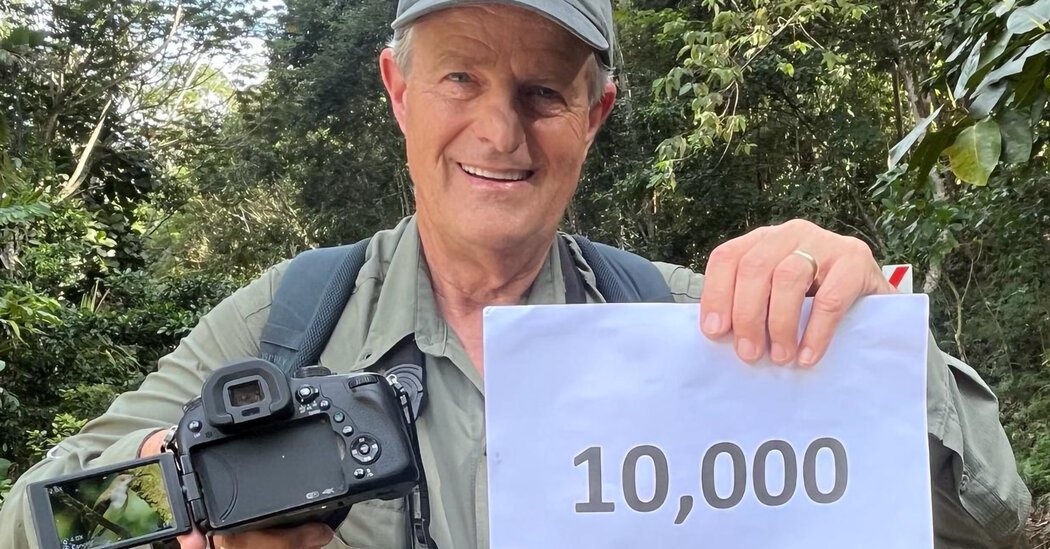On Feb. 9, Peter Kaestner stood in the shadow of majestic Tinuy-an Falls on the Philippine island of Mindanao, on the cusp of a record he’d spent seven decades chasing and worried that he’d arrived too late.
For years, nobody alive had seen and identified more bird species than Mr. Kaestner. A retired American diplomat, he is birding’s ultimate “big lister,” a star of the small but growing subculture of hypercompetitive bird watchers who scour the globe vying to see as many species as possible.
An obsessive birder since childhood, Mr. Kaestner woke up that morning in February with 9,997 birds on his personal “life list” — more than 90 percent of Earth’s scientifically recognized species and three away from a singular milestone. But he felt hurried. A few weeks earlier, in an essay for the American Birding Association, he had outlined his plans to become the first person to document 10,000 sightings; shortly after, new information forced him to expedite his plans.
“I realized when I was writing it that I was putting a target on my back,” Mr. Kaestner said from his home in Cockeysville, Md.

He didn’t waste time. Mr. Kaestner spent a chunk of January in Taiwan, racking up 15 new bird sightings. Soon he was in the Philippines, squeezing in an extra trip to the archipelago before another he had planned for March. Working with a local guide, Mr. Kaestner needed to see 19 new birds in seven days to reach 10,000. By midafternoon on Feb. 9, he had reached 9,999 when they heard an unfamiliar call coming from a nearby heliconia thicket.
When the bird appeared, Mr. Kaestner had no doubt about what it was: an orange-tufted spiderhunter, a banana-loving songbird with a sinisterly down-curved bill. Documenting the sighting with a photograph made Mr. Kaestner the first birder to reach 10,000 species, a momentous achievement once considered unreachable. “The number of people that helped over the years was extraordinary,” Mr. Kaestner said.
Depending on the taxonomic authority, scientists generally agree that there are roughly 11,000 bird species in the world. Fewer than 60 people have ever seen 8,000; fewer than 20 have surpassed 9,000.
Only 271 bird species have ever been recorded at Central Park, a world-renowned birding destination. Only around 750 are found in the U.S. and Canada.
Competitive birding has no official scoreboard. While many birders use photographs and field notes to provide evidence, documentation is largely based on a self-reported honor system. For many years, the preferred platform for Mr. Kaestner and other big listers was Surfbirds.com, before the site grew glitchy and unreliable last year. Now they use modern digital platforms like eBird and iGoTerra. Further complicating matters, the number of accepted species is constantly changing, making lists like Mr. Kaestner’s more living organism than stone tablet.
The mega-listing world is small, though, so the big players often know their competition. Mr. Kaestner had long considered Philip Rostron, a British birder, his biggest challenger, and Ross Gallardy his heir apparent.
But very few people in that world were aware of Jason Mann, an avid but little-known American birder living overseas who emerged as Mr. Kaestner’s chief competitor last year. By that point, Mr. Kaestner had his sights set on 10,000, having already broken the world record set by Claes-Göran Cederlund, who died in 2020 but has been posthumously credited with 9,829 sightings.
In January, Mr. Mann sent shock waves through the listing world when he updated his total to 9,950 from 9,600, putting him just 50 birds shy of 10,000. His list immediately raised eyebrows. Included were several species either long-presumed extinct or extraordinarily rare, like the New Caledonian nightjar, which had not been verifiably seen since 1939.
Twelve hours before Mr. Kaestner found his spiderhunter and announced his achievement online, Mr. Mann announced in a since-deleted news release that he had reached 10,000, prompting further — and fervent — online scrutiny.
“Because the two claims came out on the same day, it sort of went viral,” said Mr. Kaestner. “How in the world could this happen? This thing that has never happened in the history of mankind, that two birders get 10,000 on the same day? It’s crazy.”
The uproar deeply surprised Mr. Mann, who for 40 years had birded the world in anonymity, never identifying as a “lister.” He generally kept his records private, since spending time online undercut the foundation of his passions — being outside. In an interview, he said that his bird list was only a fraction of the 20,000-plus species of plants, mammals and other fauna he had digitized, acknowledging minor errors in the upload process but no malintent.
Amid the backlash, Mr. Mann publicly recognized Kaestner as the record-holder and again turned his list private. He said he hoped that any recent publicity helped to support bird conservation and encouraged young people to get outdoors.
“I love life, human and nonhuman, and birds are a great lens to experience that through,” Mr. Mann said. “Birding brings health and positivity, building my understanding for the interconnected web of life on which we all depend. It allows me to return to family and work recharged and with a broader perspective, like adding colors to the rainbow.”
Mr. Kaestner began birding in Baltimore, emulating his older brother, Hank, who ranks ninth in the world according to eBird. Mr. Kaestner joined the Peace Corps in Zaire after graduating from Cornell University in 1976; a subsequent 36-year career in the Foreign Service shuffled him across the globe, from under-birded places like Afghanistan and Egypt to birding meccas like India and Brazil.
He has seen at least one bird in 190 countries and territories recognized by eBird, including Antarctica. In 1986, he became the first person to see a representative of every bird family. He discovered a new species — the Cundinamarca antpitta — in 1989.
His quest led him to some of the planet’s most inaccessible places to find birds. He has navigated guerrilla-held territory in politically unstable regions in Colombia, dodged the initial Ebola outbreak in Zaire, endured near-fatal altitude sickness in Peru, thwarted car thieves in remote villages and survived flash floods. He has been lost mountain climbing in the Solomon Islands, shipwrecked in the Amazon and been guided through deep Papua New Guinea jungle by locals wearing human-skull necklaces.
“My life is almost Forrest Gump-ian,” Mr. Kaestner said. “I’ve had amazing stories of near disaster, and things have sort of just worked out beautifully. I feel incredibly lucky.”










